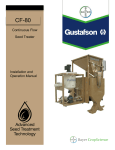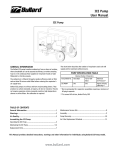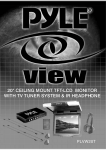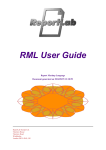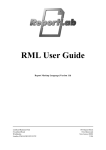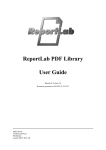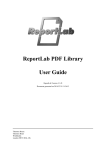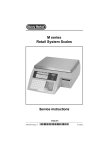Download Bayer HCBT-800 User's Manual
Transcript
HCBT-800 High Capacity Seed Treater Installation and Operation Manual This page intentionally left blank 3.0 Table of Contents The following HCBT manual contains installation, operation, parts list and technical drawing information. General categories 4.0 - Introduction 5.0 - Installation Please read and understand these instructions completely before proceeding to install and operate the equipment. Bayer CropScience reserves the right to change specifications, models, components, or materials at any time without notice. For further detailed information, contact the Bayer CropScience technical representative for your area. Please have this operation manual available when contacting Bayer CropScience. 8.0 - HCBT Drum Operation 10.0 - Seed Calibration 12.0 - CBP Tank Installation 14.0 - CBP Tank Calibration 17.0 - Treating Operation 21.0 - Maintenance 22.0 - Guidlines for Treating 23.0 - Slurry Preparation 24.0 - Calculations 26.0 - Liquid Product Worksheet 27.0 - Powder Woksheet 28.0 - Guidelines for Successful Treating 30.0 - Limited Warranty Contact Information: Bayer CropScience 4895 12th Avenue East Shakopee, MN 55379 (800)634-6738 FAX: (952)445-8282 www.bayercropscienceus.com HCBT© 2008 Gustafson Equipment RF M/013008/HCBT/579KB 4.0 Introduction Gustafson’s HCBT-800 continuous flow treater is designed for treating many crops including soybeans, wheat, rice and peas. Operators can treat from a seed holding bin or from bulk seed bags. USE CAUTION! Always use caution and common sense when working with any chemical. Read the product label and MSDS carefully and follow their instructions exactly as described. 5.0 Installation 1.Provide a mounting surface which is a floor or frame strong enough to support the HCBT and the weight of the seeds you will process at any one time. Consider also the weight of any conveying system for input and discharge as well as the weight of containers at both ends of the process. Your input feed and output collector should be of equal capacity. 2. Secure to the mounting surface a 2” X 32” angle iron directly in front of the frame on the discharge end of the HCBT. The angle iron is used to keep the HCBT from moving forward while allowing the angle of the machine to be changed for various capacities and crops. Treater Discharge End Continued... 6.0 Intstallation (continued) 3. Use a chain hoist or jack to lift the Inlet End of the HCBT approximately 6”. Treater Inlet End 4.Insert the Lift Rod into the frame hole with the head of the bolt positioned up. Treater Inlet End 5. Thread the ¾” – 10 SQ Adjuster Nut from the bottom of the bolt up to allow approximately 4” of space from the bottom of Adjuster Nut to the lower end of 4” the bolt. Adjuster Nut 6. Position the Lift Support below each bolt. Lower the HCBT to allow some weight to be on the Lift Support. Position the Lift Support parallel to the treater frame. Completely lower the HCBT onto the Lift Support. Bolt or weld the Lift Support to the floor. Lift Support 7.0 Intstallation (continued) 7. Place the Inlet Hopper on the treater and bolt in place. Inlet Hopper 8. Once the treater is permanently mounted have the machine wired by a qualified electrician. The treater requires 220 VAC / 60 HZ, 19amps, single phase. The treater has a male plug directly wired to the control box. The female end of the plug should be wired as shown. 9. Ensure that your delivery and discharge system can handle the product flow you select. Estimated capacities for the treater: Soybeans = 800 pounds per minute Wheat = 400 pounds per minute Rice = 400 pounds per minute 8.0 HCBT Drum Operation 1.Turn the Control Box Panel drum switch to ON. Control Box panel 2. Turn the drum rotation switch to F (TREAT). Control Box panel Note: When facing the discharge end of the drum, it should be rotating counter clockwise. If the drum is running clockwise turn the drum switch OFF, disconnect the power source and rewire the female plug, reversing the 120vAC supply wires (refer to stp 8 on page 7.0). Drum Rotation Continued... 9.0 HCBT Drum Operation (continued) 3.Once the drum is running counterclockwise turn the drum rotation switch to OFF. Control Box panel 4.Turn the Drum Rotation Switch to R (CLEAN OUT). The drum should be running clockwise. Drum Rotation Control Box panel 5.Turn the Drum Switch to OFF, then the Drum Rotation switch to the OFF position. Testing the HCBT is complete. Control Box panel 10.0 Seed Calibration Determine the feed rate of seed. You will need a watch or stopwatch, scale, calibrated beaker and a collection bin for the Calibration process. 1.Close the HCBT Hopper Flow Door Handle. CLOSED Hopper Flow Door handle 2.Then open the HCBT Hopper Flow Control Handle about 1-3/4”. OPEN 1-3/4” Hopper Flow Door handle SEED SOURCE 3.Position your Seed Source (i.e. bulk bag, conveyer with holding bin, holding bin, etc. with an OPEN/CLOSE seed gate) above the HCBT Inlet Hopper. HCBT Inlet Hopper Seed Source needs to have an OPEN/CLOSE Seed Gate to control the seed flow to the HCBT Inlet Hopper Continued... 11.0 Seed Calibration (continued) 4.Have a collection bin ready to catch seed from the HCBT Hopper Housing. Open the HCBT hopper flow door (Pull UP on the lip and then let it DOWN). Use the OPEN/CLOSE seed gate on the seed source bin above the HCBT inlet hopper to start the seed flow. Open Hopper Flow Door 5. Time the seed flow for one minute. Close the OPEN/CLOSE seed gate on the seed source bin. SEED Then close the HCBT hopper flow door. Seed Flow 6. Weigh the seed that has gone through in one minute. Write down your time and calculate the output per minute. Use the following example with your choice of weight per minute in place of the 600 pounds. DOWN TO REDUCE Hopper Flow Door handle UP TO INCREASE Example: 600 pounds discharge in one minute. If 600 pounds is an acceptable capacity, leave the hopper flow door in the position you have set. If the capacity is too high then reduce the opening on the hopper flow door and calibrate again. If the capacity is too low then increase the opening of the hopper flow door and calibrate again. Hopper Flow Door handle Repeat steps 4-6 until you achieve your required feed capacity. 12.0 CBP Tank Installation 1. Mount the Metering Ball Valve Assembly to the CBP-30 Tank stand with the supplied U-Bolts. Tighten to secure the mounting to the tank stand. Metering Ball Valve Mounting CBP-30 Tank 3/8” OD Tubing To Treater 1/2” OD Tubing From Pump 2. Connect 1/2” OD tubing on CBP-30 Tank Chemical Pump port to the bottom Port of the metering ball valve. Connect 3/8” OD tubing from the CBP-30 Tank metering ball valve top port to the elbow fitting under the HCBT inlet hopper. 3/8” OD Tubing to Elbow Fitting CBP-30 Tank Metering Ball Valve Continued... 1/2” OD Pump to Ball Valve 13.0 CBP Tank Installation (continued) Tank Lid 7. Fill the CBP-30 Tank with Liquid Seed Treatment Product through the Tank Lid. NOTE: Read and understand the liquid seed treatment product label and material safety data sheet (MSDS). Follow all instructions for use, handling, precautions, protective equipment and other instructions listed on the label and the MSDS. 8. Plug in the CBP-30 Tank Agitation motor 110v power cord to the 110v female connector on the HCBT Control Panel. CBP-30 Tank Power Cord 9. Turn the HCBT AGITATOR Switch to the ON position (light will go ON). 10. Turn the PUMP Switch to MANUAL and HOLD (light will go on) to deliver treatment product to the treater. This jog switch will reset to OFF when released. Installation is complete, you are now ready to test the Pump. HOLD HCBT Pump Control Switches 14.0 CBP Tank Calibration Metering Ball Valve Setting Example (refer to chart at bottom of page): Your seed output (from page 11.0) is 600 pounds per minute. Assume you are using a product that can be applied, ready to use, at a rate of 6 ounces per 100 pounds of seed. Look at the bottom of the chart and find 6 ounces. Follow the numbers up the chart to the point where it intersects with 600 pounds per minute. At 6 ounces per 100 pounds of seed: 600 pounds per minute = 54. These valve settings are approximate and are a guide to use as a starting point. SEED FLOW (LBS/MIN) CBP-30 Tank Metering Ball Valve 900 850 800 750 700 650 600 550 500 450 400 350 300 250 200 46 45 45 44 44 43 43 42 42 41 41 40 40 50 49 49 48 47 46 46 45 44 43 43 42 41 54 53 52 52 51 50 49 48 47 46 45 44 43 59 58 56 55 54 53 52 50 49 48 47 45 44 63 62 60 59 57 56 54 53 52 50 49 47 46 68 66 64 62 61 59 57 56 54 52 51 49 47 72 70 68 66 64 62 60 58 56 54 52 51 49 76 74 72 70 68 65 63 61 59 57 54 52 50 81 78 76 73 71 69 66 64 61 59 56 54 52 39 39 41 40 42 41 43 42 44 43 45 44 47 45 48 46 49 47 2 3 4 5 6 7 8 APPLICATION RATE (OZ/CWT) 9 10 Continued... 15.0 CBP Tank Calibration (continued) Adjust the Liquid Flow: 1. Disconnect the liquid treatment tubing from the elbow fitting under the HCBT inlet hopper and place it in a calibrated beaker to measure the liquid seed treatment output. 1/2” OD Chemical Pump Port 2. Turn the HCBT Pump AGITATION switch to ON. HCBT AGITATOR Control Switch 3. Hold the HCBT Pump switch to MANUAL. Measure the treatment output after one minute. Release the Pump switch to turn the pump OFF. Record your volume measurement. Pour the liquid seed treatment back into the premix tank. HOLD HCBT Pump Control Switch 4. If you do not get the desired volume in one minute, change the valve setting up or down and repeat step 3 above. Repeat this process until the output of the liquid seed treatment product is correct. When you liquid output per minute is correct, the calibration CBP-30 Tank Metering Ball Valve process is complete. Continued... 16.0 Calibration (continued) 5. Connect the liquid treatment tubing to the elbow fitting under the HCBT inlet hopper. 1/2” OD Chemical Pump Port 6. Hold the HCBT Pump switch in MANUAL to deliver treatment product to the treater. This jog switch will reset to OFF when released. HOLD HCBT Pump Control Switch The system is calibrated. Treating may begin. 17.0 Treating Operation WARNING: Do not leave the machine unattended while treating seed. The HCBT is NOT an automatic machine! Using the settings for seed feed rate (page 11.0) and liquid flow adjustment (page 15.0): 1.Turn the Control Box Panel drum switch to ON. Control Box panel 2. Turn the drum rotation switch to F (TREAT). Control Box panel 3. Turn the HCBT Pump AGITATION switch to ON. HCBT AGITATOR Control Switch Continued... 18.0 Treating Operation (continued) 4. Turn the pump switch to AUTO. The pump uses the Proximity Sensors inside the inlet hopper to indicate when liquid treatment dispersion to the treater should begin and will stop the pump as soon as the seed level in the seed hopper is lower than the proximity sensor. The Product Flow Light below the Drum Speed Dial will turn on to indicate that seed is flowing past the sensors. Pump Control Switch Product Flow Light 5.Fine tune the drum rotation by increasing or decreasing the Drum Speed Dial to get the best possible coverage and the maximum volume. WARNING: Never stop the drum full of seed, unless it is an emergency. Staring the drum when it is full of seed can cause overloads that may stress electrical components. Clean out as much Drum Speed Dial seed as possible BEFORE restarting the drum. Continued... 19.0 Treating Operation (continued) 1.When seed flow stops, turn off the Pump. The Product Flow Light below the Drum Speed Dial will turn off when seed has stopped flowing past the sensors. Product Flow Light Pump Control Switch 2.When a few seeds remain in the drum, turn the control box Drum Switch to OFF. Control Panel Continued... 20.0 Treating Operation (continued) 3.When drum rotation stops, turn the Drum Rotation Switch to R (CLEAN OUT) and turn the Drum Switch to ON and run the drum until it is empty. Control Box panel 5.Turn the Drum Switch to OFF, then the Drum Rotation switch to the OFF position. Wait for the drum to stop, then switch the drum rotation to F (TREAT) for the next treating job. Before treating other crops or varieties, ensure all switches are set to the OFF position. Inspect the entire seed system and treater. Be sure it is clean to avoid contamination of other seed sources. Control Box panel If the HCBT will not be used for a while, any liquid treatment you intend to continue using and that you have diluted with water may settle in the CBP tank, so continue to operate the agitator. If the machine will not be used for a long time, drain the premix tank (refer to page 21.0, maintenance). 21.0 Maintenance 1. Disconnect the liquid treatment tubing from the elbow fitting under the HCBT inlet hopper and place it in a secondary container. 1/2” OD Chemical Pump Port 2. Hold the HCBT Pump switch to MANUAL and Completely empty the CBP-30 Tank. HOLD This jog switch will reset to OFF when released. 3. Fill the CBP-30 Tank with clean water mixed with ammonia or a mild detergent or a cleaning solution recommended by the manufacturer of the treatment product. Repeat step 2 to flush the entire system. HCBT Pump Control Switch If the applicator is going to be stored in subfreezing temperatures, flush with alcohol to prevent freezing which will cause pump damage. Save all rinse water and use for next treatment or dispose of properly by following the MSDS sheet. If a more thorough cleaning is necessary, the metered pump kit is easily disassembled and reassembled. Tank Lid For winter storage, disconnect and drain all hoses to ensure that no components will freeze and cause damage. Clean the drum and seed chamber and spray with light food grade oil to help prevent corrosion. Store the treating unit indoors to extend the life and appearance of the unit. NOTE: Failure to clean your treater properly, or failure to completely drain all liquid from the pump and lines after use, may damage the equipment and void any warranties expressed or implied. It will not damage the pump to run it dry or with the valves in the closed position. 22.0 Guidelines for Treating Follow these guidelines for a more successful operation. 1. Avoid spouting seeds at an angle into the treater. A surge hopper installed above the treater is recommended. 2. To shut off seed flow, use the slide gate on the treater or on the holding bin. 3. Treat only clean seed. Remove dust at the holding bins and at the treater inlet. 4. Keep the weighpan tripping quickly to achieve a constant flow of seed and liquid seed treatment into the coating chamber. 5. Keep the liquid seed treatment tank lid closed during operation to keep out foreign objects. 6. In all hose lines, avoid dips and valleys where liquid may settle and not drain after treating. Keep your hoses as close to vertical as possible. 7. Protect supply hoses and bypass return hoses from abrasion, sunlight and being dislodged with PVC pipe or a similar material. 8. Adjustment to the liquid seed treatment flow should be made with the bypass adjustment valve located at the pump. Do not place valves, filters or anything that may restrict liquid flow at any point on the treatment supply hose. 9. When using a premix tank, be sure the bypass return hoses reach down into the liquid treatment. Do not cut them too short. If the hose is above the liquid level in the premix tank it can cause excessive foaming. 10.Use tap water at normal temperatures when mixing flowables. Do not use hot water. 23.0 Slurry Preparation This is the recommended sequence for adding products to produce your slurry. 1. Start with approximately 2/3 to 3/4 of the total water volume. 2. Add dyes and/or colorants. 3. Add water soluble products, such as Orthene or Ag-Strep. 4. Add wettable powders, such as Guacho 75 ST or Lorsban 50 SL. 5. Add any water-dispersible granular products. 6. Add water based flowables. 7. Add emulsifiable concentrates or concentrated emulsion products. 8. Add oil based flowables, such as DiPel ®4L. 9. Polymeric and/or coatings additives are added last (special rules may apply). 10.Use the water balance for container rinsing. Note: The 8 & 8 Rule says 8 ounces of powder will displace 8 fluid ounces of water. 24.0 Calculations KEY AI = Active Ingredient CWT = 100 pounds BU = Bushel OZ = Ounces CC = Cubic Centimeter 1. To convert rate per CWT to rate-per-bushel: multiply the rate per CWT by . (decimal point) bushel weight. Example: 4 oz per CWT on wheat = 2.4 OZ/BU 4 x .60 = 2.4 2. To convert rate per bushel to rate per CWT: divide rate per bushel by . (decimal point) bushel weight. Example: 2.4 OZ per bushel on wheat - 4 OZ per CWT 2.4 x .60 = 4 OZ per CWT 3. To calculate part per million (PPM): OZ AI/CWT .0016 = PPM 4. 5. To calculate OZ AI/CWT from PPM: PPM x .0016 = OZ AI/CWT To calculate OZ AI/FL OZ (flowable or liquid): Pounds AI/Gallon x 16 128 = OZ AI/CWT 6. To calculate OZ AI/CWT: Rate (FL.OZ/CWT) x OZ AI/FL OZ = OZ AI/CWT 7. To calculate OZ AI for powders: Rate x % active = OZ AI/CWT 8. Approximate water displacement: 1 dry OZ displaces 1 FL OZ 9. Ag strep formula: Go to Ag Strep Label under mixing instructions Add % concentration per gallon to get desired concentration per gallon of water (slurry) = OZ Ag Strep per gallon, divide by 128 = OZ of Ag Strep per FL OZ, multiply by slurry rate per CWT = rate Ag Strep per CWT 10. Pounds of seed ÷ number of trips = pounds per trip. 11. Ounces of chemical per 100 pounds of seed x 29.6 CC = total CC of treatment per 100 pounds of seed. Continued... 25.0 Calculations (continued) 12. Total CC of treatment per 100 pounds of seed ÷ 100 pounds of seed = CC per pound. 13. CC per pound of seed x pounds per trip = CC per trip (or chemical cup size in CCs). 14. Trips per minute x pounds per trips = pounds per minute. 15. Pounds per minute x 60 minutes = pounds per hour. 16. Pounds per hour ÷ bushel weight = capacity in BU/hour. FREQUENTLY USED CONVERSIONS Liquid Measure 1 1 1 1 1 cup = 8 ounces pint = 16 ounces quart = 32 ounces gallon = 128 ounces ounce = 29.6 Millilitre (cubic centimeter) Dry Measure 1 pound = 16 ounces 1 ton = 2,000 pounds 1 metric ton = 2,204 pounds 26.0 Worksheet with liquid product as part of the slurry mix Worksheet for use with powders as part of the slurry mix 27.0 28.0 Guidelines GUIDELINES FOR HANDLING SEED-APPLIED PRODUCTS AND RECOMMENDED EQUIPMENT INSPECTION AND MAINTENANCE PROCEDURES The following are general recommendations for handling seed-applied products, equipment inspection and maintenance on most Gustafson application equipment used in commercial treating facilities. There may be situations that occur outside the scope of this document that can be addressed on a case-by-case basis by contacting the appropriate Bayer CropScience personnel. Products: Flowables and Custom Blends with Flowables In many cases, custom bulk blends of some products are provided to our customers. The following are general recommendations for handling the liquid (flowables) products and the blends made from them: · Products and blends are best utilized when stored between 40-90 degrees Fahrenheit. Exposure to temperatures above and below this range for prolonged periods of time may cause the products and or blends to stratify in their containers. · Thoroughly mix all liquid products prior to use and prior to transferring into work tanks. Bulk shuttles are equipped with top and bottom ports to allow for recirculation agitation, and returnable kegs and drums have manual stirring devices inserted. 1520 minutes of recirculation is recommended for 200 and 400 gallon bulk shuttles. If the system is not set up for recirculation agitation then a mechanical agitation system will need to be installed. On returnable containers, manually rotate a minimum of 25-30 times clockwise and then a minimum of 25-30 times counterclockwise. · Where products and or blends are transferred to work tanks, any mechanical agitation devices in those tanks should be shut off to reduce the amount of product that can splash up on the sidewalls and tops of those tanks. If compressed air is used to purge lines after product transfer, use the minimum amount of air pressure necessary and make sure the work tank is vented to reduce product splashing. · After products have been transferred to their respective work tanks, resume mechanical agitation. · Do not allow the liquid level in work tanks to be pulled below two-thirds capacity so that the products and or blends have minimal exposure to air and do not dry and or cake prematurely. Guidelines 19.0 General Equipment · Check filters daily at least once. Clean rinse off as necessary. The filter assemblies are intended to keep agglomerates, plant debris and other foreign substances from going through the system and plugging lines. If an accumulation of material is found, the filter basket should be removed and rinsed free of the debris. · Clean pump and product lines frequently to avoid an accumulation of product buildup over time. · Avoid low spots or bows on hoses and supply lines where products may have a tendency to accumulate and or settle. · If the treating system is being shut down for a weekend or more, fill the work tanks to their maximum level and flush any product from the lines to avoid any potential product settling. · Product supply lines running from a pump to the application equipment should be installed so they run laterally and up to the treater to ensure constant flow and complete product removal when the lines are drained. Electronic and CBT Treating Systems · Conduct ‘on-the-go’ calibration checks frequently by checking the amount of product being pumped from the closed calibration cylinder versus the product delivery rates that the computer is indicating. GLCPS systems rely on peristaltic pump hose integrity; wear and tear on it will affect the calibration. Periodic inspection and recalibration should help improve calibration accuracy. · Make routine ‘loss-in-weight’ calibration inspections when product supply tanks are mounted on weighing scales. While the machine is running, a loss in weight should be observed. The elapsed time for this weight loss can be used to cross check accuracy against the rate per minute displayed on the computer screen. · On the CBT-200 batch treaters, inspect the 20-l batch weighing tank used to receive and dispense any products. If an accumulation of product is visible it should be removed and cleaned. 30.0 Warranty LIMITED WARRANTY, LIMITATION OF LIABILITY & CLAIMS Bayer CropScience warrants that the Gustafson application equipment shipped hereunder shall be free of defects in materials or workmanship for a period of one (1) year from the date of delivery. BAYER CROPSCIENCE MAKES NO OTHER WARRANTY, INCLUDING, WITHOUT LIMITATION, ANY WARRANTIES OR MERCHANTABILITY OR OF FITNESS FOR A PARTICULAR PURPOSE, WHETHER EXPRESSED OR IMPLIED. IN NO EVENT SHALL BAYER CROPSCIENCE BE LIABLE TO CUSTOMER FOR ANY INCIDENTAL, CONSEQUENTIAL, SPECIAL OR PUNITIVE DAMAGES REGARDLESS OF WHETHER ARISING IN CONTRACT, STRICT LIABILITY, OTHER TORT OR OTHERWISE. THE EXCLUSIVE REMEDY OF CUSTOMER FOR ANY AND ALL LOSSES, INJURIES OR DAMAGES RESULTING FROM THE SALE, USE OR HANDLING OF THE GUSTAFSON APPLICATION EQUIPMENT WHETHER IN CONTRACT, WARRANTY TORT, NEGLIGENCE, STRICT LIABILITY OR OTHERWISE, SHALL NOT EXCEED THE PURCHASE PRICE PAID, OR AT BAYER CROPSCIENCE’S SOLE ELECTION, THE REPAIR OR REPLACEMENT OF APPLICATION EQUIPMENT. No shipment of Gustafson application equipment, or any portion thereof, is returnable by customer, unless such shipment or portion thereof is defective in one or more of its components. In the event that customer believes that the Gustafson application equipment is defective, written notice must be provided to Bayer CropScience by customer within one (1) year after the date of delivery of the equipment. Failure to provide such notice shall constitute customer’s irrevocable acceptance of the Gustafson application equipment and waiver of any claims for errors, deficiencies, or imperfections therein. Any attempt to return a shipment of Gustafson application equipment, or portion thereof, for any other reason after the expiration of the time period set forth herein shall be an ineffective rejection of such Gustafson application equipment, and customer shall be invoiced by Bayer CropScience and shall pay the invoice in full, including any storage, freight, or other costs for returned Gustafson application equipment or any portion thereof. Upon notice to Bayer CropScience that the application equipment is defective, Bayer CropScience shall have the right to send a representative to customer’s facility, or inspect the equipment after having received it from customer. If Bayer CropScience determines that any Gustafson application equipment is defective, Bayer CropScience shall replace such application equipment at its expense. If Bayer CropScience disagrees with customer’s conclusion that the Gustafson application equipment is in any way defective, or if the defect or damage was caused, directly or indirectly, by customer’s action or inaction, customer shall be charged for all costs associated with sending the equipment or replacement parts to customer. Notwithstanding the foregoing, the limited warranty contained herein does not apply to the following: Maintenance - This includes, but is not limited to, such things as cleaning, flushing systems, corrosion prevention, mechanical or electrical adjustments, or repairs which become necessary through normal wear and tear; or periodic maintenance such as lubrication and gear or variable speed oil changes. Service and wear items - This includes, but is not limited to, the replacement of belts, drive chains, sprockets, fasteners, bulbs, fuses, ball bearings, bushings and other electrical or mechanical components that have a useful life based on how much these components are used. Lack of service - This includes, but is not limited to, damage attributable to failure to perform maintenance in services in accordance with the manufacturer of the component. Damage - This includes, but is not limited to, damage resulting from negligence, improper installation, the installation process, improper or incorrect wiring, corrosion, construction welding, or freight damage. Controls - Systems without Bayer CropScience supplied control packages or systems using other controls are not covered under the terms of this warranty. TRAINING, CALIBRATION ASSISTANCE AND SERVICE CALLS Bayer CropScience trained employees may assist in the training and calibration of equipment - Due to factors such as temperature variations, seed flow changes, improper mixing procedures and other factors that are out of Bayer CropScience’s control, Bayer CropScience does not accept responsibility for the calibration of the system. Electronic controlled seed and chemical proportioning systems - Infield training and calibration assistance of up to 15 hours or 1 trip to the purchaser’s location is included in the price of qualified electronic controlled seed and chemical proportioning system. Additional hours will be billed to the purchaser at $60 per hour plus travel expenses for units in the continental United States. Electronic controlled seed and chemical proportioning systems purchased outside of the continental United States $60.00 per hour portal to portal will be billed to the purchaser. Service calls for non-warranty items will be charged at $60.00 per hour portal to portal plus expenses. All other standard application equipment - Service calls for non-warranty items will be charged at $60.00 per hour port to port. This page intentionally left blank Bayer CropScience 4895 12th Avenue East Shakopee, Minnesota, 55379 USA www.bayercropscienceus.com
































